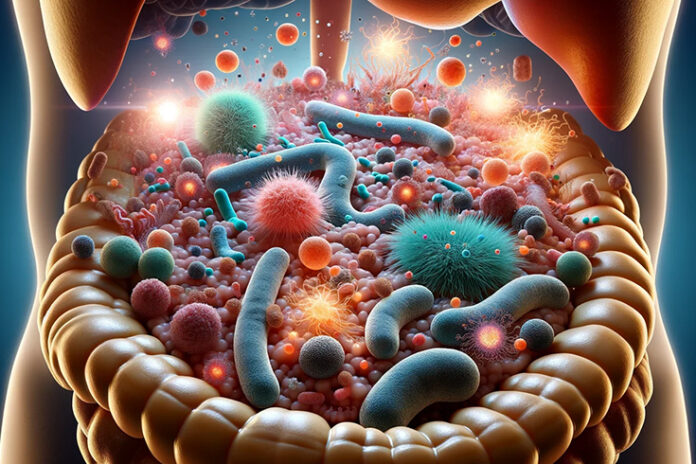By Olivier Felicio
For years, calcium has been viewed primarily through the lens of skeletal health. But new research is pushing beyond the bones—highlighting calcium’s nuanced role in shaping the gut microbiome, particularly during the fermentation of prebiotic fibres like inulin and lactose. For formulators, nutritionists, and integrative health practitioners, these findings present an important shift: the form of calcium used in a formulation can influence microbial balance, metabolic outputs, and ultimately, nutrient absorption.
A recent in vitro study investigated how three common calcium salts—calcium phosphate (CaPi), calcium citrate (CaCi), and calcium carbonate (CaCa)—affect microbial diversity and short-chain fatty acid (SCFA) production in simulated colonic conditions. These fermentations were carried out under varying pH levels, mimicking the natural gradients of the colon, to examine how local environments modulate these effects.
Key Takeaways for Clinical and Product Strategy
- Calcium Phosphate (CaPi) showed consistent microbiome modulation across all pH gradients. It promoted beneficial genera like Leuconostoc early in fermentation and Blautia after 24 hours, while suppressing Bacteroides, a genus often elevated in Western dietary patterns associated with inflammation and metabolic imbalance.
- Calcium Citrate (CaCi) enhanced acetate production, particularly in low and high-pH environments. Acetate is a major SCFA associated with maintaining gut barrier function, supporting mucosal immunity, and regulating host metabolism.
- Calcium Carbonate (CaCa) drove lactate production under low and medium pH levels. Lactate serves as a precursor for other SCFAs and is integral to cross-feeding interactions between microbial species—highlighting its potential value in shaping a resilient microbial ecosystem.
- Bifidobacterium, a core genus in probiotic formulations, remained above 1% abundance across all conditions, suggesting resilience to both calcium form and pH variability—useful information for practitioners concerned about the survivability of probiotics in diverse gut environments.
Why This Matters for Practitioners and Product Developers
This study reinforces the importance of ingredient synergy for those working at the intersection of clinical nutrition and functional formulation. The form of calcium selected can influence more than bioavailability—it can shape fermentation pathways, select beneficial microbes, and modulate the production of metabolites with systemic effects.
This is especially relevant when designing products for:
- Gut health and microbiome support
- Postbiotic-rich formulations
- Calcium supplementation for individuals with GI sensitivities
- Nutritional interventions for metabolic or inflammatory conditions
Strategic Considerations
- When formulating synbiotic products (combining prebiotics and probiotics), choosing the appropriate calcium salt may enhance outcomes by selectively influencing microbial composition during fermentation.
- Practitioners recommending inulin or lactose-based prebiotics should be aware that calcium form—and individual pH variability—may affect how those fibres are metabolized and which microbes dominate the fermentation process.
- The study underscores the importance of colonic pH as a variable in gut health—a parameter rarely discussed in clinical settings but essential in understanding interindividual responses to supplementation.
Calcium isn’t just about bones anymore. In the context of fibre fermentation and microbiome health, form matters. As research continues to illuminate the microbiota-nutrient interface, practitioners and product developers have a growing opportunity to personalize interventions based not only on nutrient needs—but on how those nutrients interact with the complex ecology of the gut.
Key Findings at a Glance
Calcium Phosphate (CaPi)
- Promotes Leuconostoc (early) and Blautia (later)
- Suppresses Bacteroides across all pH levels
- Supports microbial diversity
Calcium Citrate (CaCi)
- Increases acetate production at low/high pH
- May enhance mucosal health and systemic metabolism
Calcium Carbonate (CaCa)
- Boosts lactate production at low/medium pH
- Encourages SCFA cross-feeding among microbes
Bifidobacterium
- Remains stable across all calcium forms and pH levels (>1%)
- Reliable component in probiotic formulas
Practical Takeaways for Product Developers
When designing supplements that include prebiotics like inulin or lactose, the choice of calcium salt matters. For example:
- Synbiotic formulas could benefit from CaPi’s ability to selectively boost beneficial microbes like Blautia.
- Postbiotic-focused products might leverage CaCi for its acetate-enhancing effect.
- GI-support formulations for sensitive populations may do better with CaCa, especially where lactate production is desirable.
These findings also validate the functional use of minerals beyond RDI targets. Calcium form isn’t just a delivery system—it’s an active influencer of microbial ecology and metabolic signalling.
Formulator’s Note: Colonic pH as a Hidden Variable
pH variability in the colon—shaped by diet, stress, medication, and disease—can change how fibres are fermented and how microbes respond to minerals. Consider formulating with pH adaptability in mind, or educating clients on lifestyle factors that may affect colonic pH (e.g., high-protein diets may lower it).
Clinical Insights for Practitioners
For integrative clinicians, this research suggests new avenues for personalized micronutrient strategies. In patients with gut dysbiosis, metabolic disorders, or poor SCFA production, calcium form may act as a therapeutic lever when paired with the right prebiotics.
Additionally, this study supports the use of targeted formulations for different sections of the colon, based on localized pH gradients and microbial patterns.
Calcium Form vs. Microbiome Impact Chart
| Calcium Salt | Boosts | Reduces | SCFA Impact | Best Use Case |
|---|---|---|---|---|
| CaPi | Leuconostoc, Blautia | Bacteroides | ↑ Lactate | Synbiotic formulations, gut inflammation support |
| CaCi | Acetate-producing microbes | Bacteroides (pH dependent) | ↑ Acetate | Metabolic support, gut barrier repair |
| CaCa | Lactate-producing microbes | Bacteroides (pH dependent) | ↑ Lactate | GI-sensitive clients, early-stage postbiotic support |









